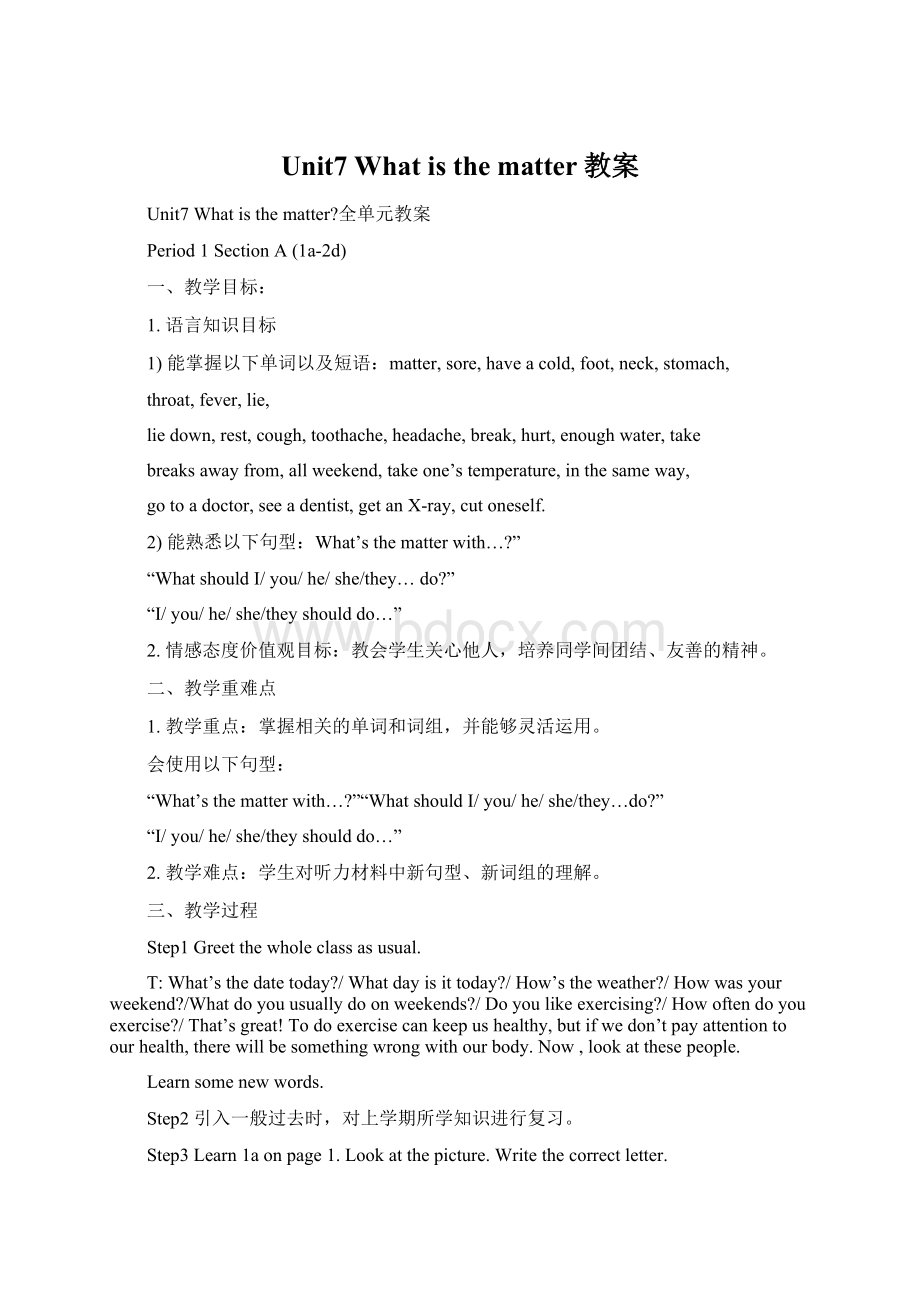Unit7What is the matter教案.docx
《Unit7What is the matter教案.docx》由会员分享,可在线阅读,更多相关《Unit7What is the matter教案.docx(9页珍藏版)》请在冰豆网上搜索。

Unit7Whatisthematter教案
Unit7Whatisthematter?
全单元教案
Period1SectionA(1a-2d)
一、教学目标:
1.语言知识目标
1)能掌握以下单词以及短语:
matter,sore,haveacold,foot,neck,stomach,
throat,fever,lie,
liedown,rest,cough,toothache,headache,break,hurt,enoughwater,take
breaksawayfrom,allweekend,takeone’stemperature,inthesameway,
gotoadoctor,seeadentist,getanX-ray,cutoneself.
2)能熟悉以下句型:
What’sthematterwith…?
”
“WhatshouldI/you/he/she/they…do?
”
“I/you/he/she/theyshoulddo…”
2.情感态度价值观目标:
教会学生关心他人,培养同学间团结、友善的精神。
二、教学重难点
1.教学重点:
掌握相关的单词和词组,并能够灵活运用。
会使用以下句型:
“What’sthematterwith…?
”“WhatshouldI/you/he/she/they…do?
”
“I/you/he/she/theyshoulddo…”
2.教学难点:
学生对听力材料中新句型、新词组的理解。
三、教学过程
Step1Greetthewholeclassasusual.
T:
What’sthedatetoday?
/Whatdayisittoday?
/How’stheweather?
/Howwasyourweekend?
/Whatdoyouusuallydoonweekends?
/Doyoulikeexercising?
/Howoftendoyouexercise?
/That’sgreat!
Todoexercisecankeepushealthy,butifwedon’tpayattentiontoourhealth,therewillbesomethingwrongwithourbody.Now,lookatthesepeople.
Learnsomenewwords.
Step2引入一般过去时,对上学期所学知识进行复习。
Step3Learn1aonpage1.Lookatthepicture.Writethecorrectletter.
arm,back,ear,eye,foot…
Step41bListenandlookatthepicture,thennumberthenamesonpage1.
NancySarahDavid…
Step5Practicetheconversations.
What’sthematterwith…?
Shetalkedtoomuchyesterday.
知识点归纳:
当某人心情沮丧,闷闷不乐,身体不舒服或是遇到麻烦事时,可以用下列问句:
What’sthematter?
What’swrongwithsb/sth?
某人/某物怎么了?
(sb:
哪儿不舒服/出什么事了/为何不高兴?
sth:
某物出了毛病或故障)可以用下列问句:
What’sthematterwithyou?
/What’sthetroublewithyou?
/What’syourtrouble?
/What’swrongwithyou?
/Isthereanythingwrongwithyou?
Step6Listenandnumberthepicturesonpage2.
Step7Listenagainandthenmatch.
知识点归纳:
Youshoulddrinksomehotteawithhoney.
(1)with做介词,意为“有,带有”表示某物带有或具有某种特征。
介词短语
withhoney做hottea的后置定语。
例:
atallgirlwithlongcurlyhair.
(2)with还有“和某人某物在一起”,表示伴随。
例:
Iliketotalkwithmyfriends.
with还有“用……”表示使用“某种工具、手段等”
例:
Cutitwithaknife/wirtewithapen/withthehelpof……或withone’shelp
with还有“关于……对于……”表示“关系和适应范围”例:
beangrywith
Step8Role-playtheconversation.
先带领学生学习书中对话部分所出现的语法知识,新的词组以及新的句型。
并要求学生熟读本部分课文。
Step9Homework
教学反思:
Period2(3a-Grammarfocus)
一、教学目标:
1.语言知识目标:
1)单词以及短语:
passenger,getoff,onto,toone’ssurprise,trouble,hit,
rightaway,getinto,herself,seesbdoingsth,thanksto,savealife,thinkabout,intime,wait
for,take…to…,tell…todo…
2)巩固一般过去时,熟练使用动词的过去式。
2.能力目标:
运用推理判断法解阅读理解题
3.情感目标:
培养学生主动救助处于危险中的人的精神,在紧急关头,有勇气做出正确的决定。
二、教学重难点
1.教学重点:
一般过去时的复习;
2.教学难点:
在阅读材料中,准确地提取所需信息。
三、教学过程
Step1Learnsomenewwordsandreviewthewordsthatwelearnedyesterday.Step2复习一般过去时态,并带领学生复习常见动词的过去式。
seerungetsayknowstopsave….
Step3先让学生自己阅读教材3页的文章,并找同学说出本篇文章的大概内容。
Step4在学生熟读课文后,带领学生一起分析文章中出现的短语、语法点以及句型。
seesbdoingsth,getoff,withoutdoingsth,intime,thinkabout,thanksto,waitfor,agreeto…
本篇文章内容是当今社会议论广泛的话题,即在路上遇到有人摔倒要不要过去帮忙,要正确引导学生。
Step5Readthepassageagainandcheckthethingsthathappenedinthestoryonpage3.
知识点归纳:
用have来回答健康问题新课标第一网
(1)haveacold中have意为“患、得(病)”
(2)have意为“拥有”之意时,无进行时。
(3)have做“进行、举行”解,表示“举行某一活动”例:
WewillhaveabigpartyonNewYear’sDay.
(4)have做“吃、喝”解,可指吃三餐饭或具体食物。
例:
Ihavetomatoesforlunch.(5)have做“上……课”解,例:
Howmanyclassesdoyouhaveonweekdays
Step63cDiscussthequestionswithapartneronpage3.
Step7带领学生分析每一句的话的含义。
Workingroupsanddiscusshowtokeepourselveshealthy.
ShouldShouldn’t
Step8Grammarfocus.本部分内容要求学生记忆,并能熟练运用。
Step9总结本节课所学内容。
Step10Homework.
教学反思:
Period3(4a-SectionB1d)
一、教学目标:
1.语言知识目标:
1)能掌握以下单词以及词组:
falldown,getsomerest,cutone’sknee,hurt
one’sback,feelsick…
2)能掌握含有should的用法。
2.能力目标:
提高学生的听的能力以及口语交际能力。
3.情感目标:
引导学生正确面对生活中遇到的困难,爱惜身体,坚持锻炼。
二、教学重难点
1.教学重点:
Should的用法
2.教学难点:
教材中出现的词组的掌握以及对听力材料的理解。
三、教学过程
Step1Learnsomenewwordsandphrasesonpage4.
Step24a.Fillintheblanksandpracticetheconversationsonpage4.
Therearefourconversationsinthispart.
Step3Circlethebestadviceforthesehealthproblemsonpage4.
.Sheshould…;Theyshouldn’t…;
知识点归纳:
在英语中,表示“疼痛”或“不舒服”常用的有ache,sore,pain,hurt等。
其用法总结如下:
(1)“主语+have/has+病症”例:
Joehasabadcold./Joehasahighcold
(2)“主语+have/has+a+sore+发病部位”例:
Joehasasorethroat/bake.XKb1.Com
(3)“主语+have/has+a+部位ache”
例:
Joehasatoothache/stomachache/backache/headache.
(4)“部位+hurt(s)”表达某一具体位置的疼痛hurt是动词,意为“疼,痛”其过去式仍为hurt
例:
Joehasatoothache/stomachache/backache/headache.
(5)“(thereis)somethingwrongwith+one’s+部位”
例:
Ican’tseeanything.Ithinktheremustbesomethingwrongwithmyeyes.Advice的用法:
(1)advice“建议、忠告、劝告”不可数【u】apieceofadvice一条建议asksbforadvice征求
某人的建议givesbsomeadvice给某人一些建议takeone’sadvice接受某人的建议
Canyougiveapieceofadvice?
/Heoftengivesussomegoodadvice./Youshouldtakehisadvice.
(2)advise“建议、劝告”为动词,advisesbofsth把某事通知某人/Iadviseyoutoleavenow.
Step4Conversationpracticeonpage4.
A:
What’sthematter?
Didyouhurtyourselfplayingsoccer?
B:
No,Ididn’t.
A:
Didyoufalldown?
B:
Yes,Idid.
…
知识点归纳:
should为情态动词,意为“应该”,否定式为shouldn’t,表示建议,要求。
其后加动词原形,且无人称和数的变化。
Youshouldbrushyourteethbeforeyougotobed.情态动词有词义,但不能
单独做谓语,必须和其他动词一起构成谓语,表明说话者对所要表达意思的态度和看法最重要的是,情态动词没有人称和数的变化,其后必须跟动词原形。
变为否定句时,直接在情态动词后加not.常见的情态动词有can,may,must,need,should,will,would,shall等。
Step51aWhentheseaccidentshappen,whatshouldyoudo?
Puttheactionsinorderonpage5.
Putabandageonit.
Runitunderwater.
Putsomemedicineonit.
….
Step6Listentotheschoolnurse.Checktheproblemsyouhearonpage5.
Step7Listenagain.Writetheletterofeachtreatmentnexttotheproblemsyoucheckedinthechartaboveonpage5.
Step6Role-playtheconversationbetweenthenurseandtheteacher.
补充部分:
Whendiditstart?
Start做动词时,后接名词、代词做宾语,或与动名词和不定式连用。
(1)Start/begindoingtodo意为“开始做某事”例:
Theystarteddancing/todance=Theybegandancing/todance.
(2)begin与start区别,当start作“动身,发动,开办,流出,惊起等”时,不能用begin代替。
(3)start…with/begin…with均意为“以……开始”Thewordbegins/startswith“s”.(4)atthestartof与atthebeginningof意为“在……开头/开端”例:
We’regoingtoschoolatthebeginning/startofseptember.
Step7Summary.
Step9Homework:
教学反思:
Period4SectionB(2a-2d)
一、教学目标:
1.语言知识目标:
1)能掌握以下单词以及词组:
breathe,sunburned,ourselves,climber,beused
to,risk,takerisks,accident,situation,kilo,rock,run
outof,knife,cutoff,blood,mean,getoutof,,
importance,decision,control,beincontrolof,
spirit,death…
2)能掌握以下句型:
进一步了解文中出现的定语从句,时间状语从句等;理解文章的含义。
2.能力目标:
提高学生的阅读能力,即理解文章的能力;总结归纳文章中知识点的能力。
3.情感目标:
培养学生敢于面对生活中出现的挫折的精神,拥有坚强的意志力。
二、教学重难点
1.教学重点:
Masterthekeyvocabularyandexpressions.
2.教学难点:
定语从句、时间状语从句以及宾语从句的理解。
.
三、教学过程
Step1Learnsomenewwordsandphrases.
Step22a.在参加某种体育活动时,可能出现的风险,请学生搭配词组。
本部分为阅读部分做铺垫。
Step3Letthestudentsreadthetext.
在学习文章前,一定要求学生熟读文章,并能提出自己的看法。
Step4讲解第6页文章中出现的知识点。
edto,be/getusedtodoing,beusedtodo的用法区别
usedtodo过去常常……be/getusedtosth./doingsth..习惯于……beusedtodo被用来做……
(1)usedtodosth.过去常常……(现在已不如此)
Weusedtogrowbeautifulroses.
注意:
否定句和疑问句有两种
Youusedn’ttomakethatmistake.Shedidn'tuse(d)todoit,didshe?
Youusedtosmokeapipe,didn'tyou?
/use(d)n'tyou?
【区别】
(2)be/get/becomeusedto+n./doing习惯于
Ihavealwaysbeenusedtohardwork.Hegotusedtolivinginthecountry.
(3)beusedtodo被用来做……Thisknifeisusedtocutbread.
中考链接
()1.There________alotofred-crownedcranesinthisarea.
A.wasusedto
B.wasusedtobe
()2.Sheusedto______withherparents,butnowsheisusedto______withherclassmatesatschool.(泰州)
A.live;living
B.live;live
C.living;living
D.living;live
()3.Heusedto____inasmallvillage,butnowhehasbeenusedto___inthebigcity.(镇江)
A.live;living
B.live;live
C.living;living
D.living;live
()4.MrsGreen_______gotohospital,butnowsheisingoodhealth.
A.hasto
B.needto
C.oughtto
1.Mycousinisusedto________(study)withhisnewfriendsinAustralia.(南京)
2.Mymotherisusedto________(get)upearlytocookbreakfastforus.(一模)
3.MrBushisusedto__________(get)upearlyinthemorning.
4.JimhaslivedinAustraliafortwoyears.Heisusedto_________(驾驶)ontheleft.Step52conpage
Step62d.Readthepassageagainandanswerthequestionsonpage7.
Therearefivesentencesinthispart.
Step7Summary
Step8Homework:
课后反思:
Period5SectionB(2e-selfcheck)
一.教学目标:
二.1.语言知识目标:
Makeacomprehensivereviewofthewholeunit.
Checkhowwellthestudentshavemasteredtheunit.
2.能力目标:
提高学生写作能力及自主学习的能力。
3.情感目标:
培养学生良好的学习习惯,即认真思考、提前预习、课后复习的习惯。
二、教学重难点:
1.教学重点:
Doselfcheck.
2.教学难点:
Howtoconsolidatetheunitanddoselfcheck.
三、教学过程
Step1Tpreparessomepiecesofpaper,andwritedowntheproblemsonthepaper.ThenTgetssomestudentstocometotheblackboardandactout.Theotherstrytoguessthemoutandgivetheadvice.
A:
What’sthematterwith…
B:
Doesshehave…/Isshe…
B:
Sheshould…
Sheshouldn’t…
Whileplayingthisgame,wecanletthestudentshaveacompetition.
Step2.Presentation
T:
Sotherearelostofproblemsinourlife.Butwhydowehavesuchproblems?
Nowlet’slookhere.Whoisthisman?
S:
HeisLiShizhen.
T:
Whatdoeshedo?
S:
Heisadoctor.
T:
HeisatraditionalChinesedoctor.
Thisishisfamousbook.Itiscalled本草纲目.Therearelotsofherbsinthebook.Forexample,DangshenandHuangqi.Itisgoodforthehealth.
Allthepeoplewanttobehealthy.Itisveryimportanttobehealthy.
Step2WriteatraveldiarylikeJane’sonpage5.
该部分内容已在课前安排,指导学生正确使用一般过去时。
Ste32eonpage7.Putthesentencesinthecorrectorder.Thenusethemtotellyourpartner.
知识点归纳:
I’mnotfeelingwe